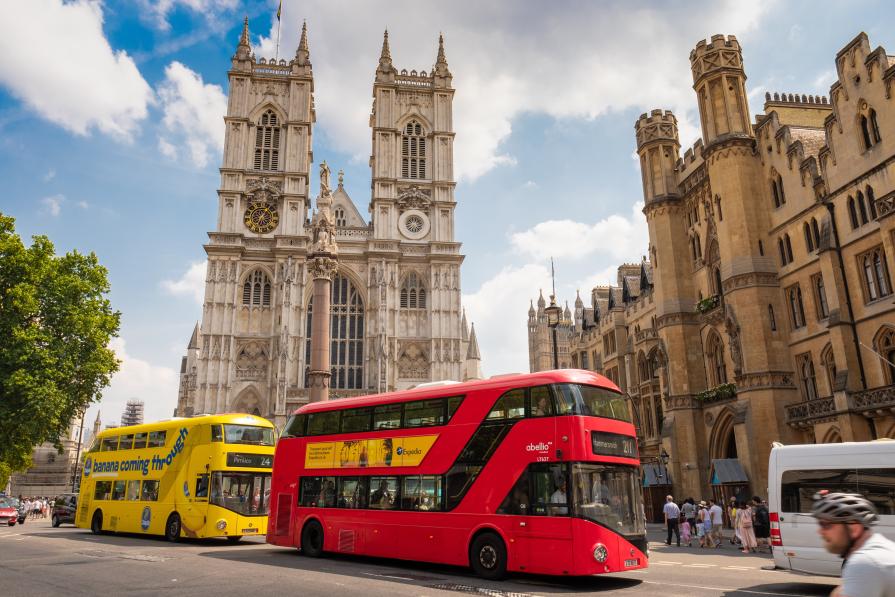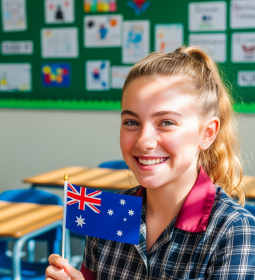The British secondary school is considered one of the best in the world, even American rankings note its quality, putting it in second place after its own American one. Among the key features of the British model are its comprehensive and interdisciplinary nature (from the 1st grade, schoolchildren study 8-10 subjects covering all spheres of human life, including technology, arts and sports, contributing to the expansion of horizons), early specialization (in the last two years, children study only those disciplines that they need at the university), excellent conditions for teachers, including in public schools.
A British secondary school offers excellent conditions for foreign students, adjusted for tuition fees, and equal access to education: the scholarship program in the UK is not as extensive as in private schools in the United States, but it also helps to significantly reduce the costs concerning obtaining a certificate.

Finally, a student of a British school is an independent person. The educational process here at all levels, from kindergarten and primary school to postgraduate education, is aimed at developing such qualities as abstract and critical thinking, initiative, the ability to search for and process information. For example, already in secondary school, teenagers conduct independent research and write essays on a variety of topics.
Features of secondary education in the UK

British schools can be private and public. State, in turn, are divided into several types - the classification depends on the type of curriculum, sources of funding, founder and the presence/absence of selective admission and specialization. Education in the country is compulsory, so all Britons, from 5 to 16 years old, must attend school. Public schools are free for His Majesty's subjects.
Foreign students can only study in private schools. These, in turn, can be day or boarding schools, and mostly expats study in boarding schools. At the same time, even at a boarding school, a foreign child needs a guardian (who can be selected with the help of a special agency).
In a day school, the child only studies, and in a boarding school he both studies and lives. Boarding houses have comfortable bedrooms (younger pupils live in a room of several people, and older teenagers can count on single or double rooms), well-established and extensive infrastructure: game and recreation rooms, stadiums, canteens, libraries, etc. Boarding schools accept pupils from 11-13 (less often from 8) years old.
The UK is one of the few countries where separate form of studying remains quite popular. There are all-male and all-female schools, a large number of mixed ones (and the Sixth Form, senior classes, are increasingly mixed even in all-male schools). Other private schools are gradually abandoning gender segregation — for example, from 2024, general education was introduced in the five-hundred-year-old Westminster School. However, you can choose any option for your child.
Most boarding schools have houses. The Houses have their own structure, their own dormitories, common rooms closed to students from other Houses, identity (in addition to the coat of arms, it can also be the color of the tie or a badge), their own customs and traditions. Often, elementary school students live together with older students, contributing to close communication and lays the foundation for friendships for years and decades.
Benefits of British Secondary Education

-
Guesthouse
Despite the fact that there are day schools, the main format for expats is still boarding school. There is everything to study, relax and live comfortably, and parents do not have to worry about where the child is, what he did for himself, what he eats and whether he is well dressed before going outside.
-
Comprehensive Nature of Learning
The British National Curriculum, which is the basis of the programs of most independent schools, is formed in such a way as to give the child basic (and at the same time quite deep) knowledge in various fields, to link this knowledge with each other, providing it an interdisciplinary character. Schoolchildren study modern and ancient languages, the basics of religion, learn to be socially responsible, learn the basics of economics and law, get an idea of the advantages of a healthy lifestyle and are actively involved in sports.
-
Highly effective programs
In terms of the level of studying, British private schools have no equal: if in general, students of British schools occupy 14th, 23rd and 22nd places in the world in mathematics, natural sciences and English, respectively, then for private schools we are already talking about 4th, 11th and 9th lines.
-
Community & Fellowship
The system of Houses and close ties with teachers in British boarding schools contribute to the development of a sense of community and real camaraderie, support and mutual assistance. Often alumni help each other and become friends years after graduation from school.
-
Scholarships
British education is of high quality and not cheap, but many schools give discounts, for example, for the second and third child in the same school, and also offer scholarships (both based on financial need, and for success and achievements in various fields).
-
Applicant support
It will be easier for an expat with experience of studying in England to enter any university in the world. The easiest way, of course, is to go to the British one – there will be no need for legalization of documents, problems with language tests and the missing year, in addition, the child will already be familiar with the teaching style in British schools. Most schools provide high school student support programs designed to help them pass the entrance exams.
Disadvantages of teaching in British secondary schools

Along with the undoubted advantages, studying in secondary school in the UK has a number of features.
-
Prices
Studying in England, Scotland, and any other part of the United Kingdom is expensive, higher only in the United States and Switzerland. In addition, you need to pay for housing, educational materials, pocket money... To study in a state school, you need to pay taxes in the UK as a citizen or at least a resident.
-
Custody and Residence
Until the age of eighteen, any schoolchild and even student in the UK needs a guardian, who must be a citizen of the country over 25 years old. The good news is that a guardian can be hired. However, it costs much.
-
Difficult admission
It is not easy to enter a British private school, almost everywhere you have to pass complicated, often multi-level entrance exams. Usually, you will also be interviewed and "tested" the school for a day or two. Usually, all exams and interviews are conducted in person, but foreign students are exceptionally given the opportunity to do this online or at the British Council offices.
How does the secondary education system work in the UK?

The school system in the United Kingdom includes two levels, primary and secondary, respectively. They, in turn, are divided into key stages.
Grade school
In elementary school, there are two key stages: key stage 1 (equivalent to the 1st and 2nd grades, for children 5-7 years old) and key stage 2 (these are grades 3 to 6, they study here until 11-12 years old).
In primary school, traditional assessments are not used - instead, four levels are used, designed to reflect the level of development of the child and the degree of compliance with expectations, and each school has its own assessment criteria, there are no universal rules and standards. But there are standardized exams, or SATs, which are taken after the 2nd and 6th years of study. In the first case, these are tests in mathematics and reading, in the second, the level of mathematics, reading, grammar, punctuation and literacy is assessed. It is impossible to fail the test, they do not leave for a second year, but when moving to secondary school in this case, there will be nuances.
Secondary education
Graduates of primary school go to secondary school: in the case of schools funded by the authorities, this happens automatically, but in private schools you need to pass special exams - Common Entrance.
Secondary school also includes two key stages – 3 (children from 11 to 14 years old and from 7th to 9th grade) and 4 (14-16 years old, up to and including 11th grade). At the third stage, several more disciplines are added to the already mentioned compulsory subjects - career guidance, gender education and citizenship (something between social studies, civics and "Conversations about Important Things").
The entire course of study is divided into 3 blocks:
- Core disciplines - mathematics, English and 3 natural science disciplines;
- Elective subjects (optional) — here you can choose works and geography, social sciences and design, art or dance, theater or computer technology;
- Extension - additional courses, each school has its own.
The curriculum is divided into trimesters, at the end of each student there is a week of credits (the grading system is nine-point).
From the age of 14, teenagers begin to prepare for the final exams - General Certificate of Secondary Education (GCSE). They are taken in all subjects of the compulsory course, and in return, the student receives a certificate, with which he can go to work or continue studying at college. You cannot immediately enter a university with GCSE, for this you need to study for another two years in high school.
High school
Better known as A-level or Sixth Form, they are also key stage 5. These two years, teenagers are preparing to enter high school. In the UK, there are several versions of the program, the most common is A-level (IB and other national standards are less common), where students are given knowledge at a level much higher than the school level. There are no compulsory disciplines at this level – you decide what you want to learn, depending on who you are going to become. Usually, in the first year of Sixth Form, students take 3-5 courses, and in the second year you can refuse from 1-2 - so you can focus your efforts on the main discipline.
There are no classes either - students situationally gather together to study in a subject that is specialized for them. There may be 25 people, or only 2-3. The schedule is intensive, from 8:30 to 16-17:00, with a lunch break, additionally from 7 to 16 academic hours for self-study. The Sixth Form places great emphasis on workshops and essays, individual and collective projects, and creative students will be expected to assess their portfolios.
In the final, everyone will have exams, which are taken in January-February or June. The exam grade is the final grade. Letters from A* to E are used for evaluation, where A* is the highest score. These same grades will then be used for admission. To succeed, you need to pass 3 exams in your profile, so the requirements for applicants may contain the abbreviation AAA or ABB, even A*A*A (but the latter is rare). In fact, such an abbreviation is the entrance requirements for a specific specialty of a particular university.
A-level also has a huge advantage, which in many ways is in common with IB: you can apply with the results of such exams not only to British, but also to American, Canadian, Australian and even many European universities. A-level is also quoted in some universities in India and other Asian countries.
Tuition fees in schools in England

The pleasure of studying in the UK is not cheap. Of course, a lot depends on what kind of school it is, where it is located, on its history and position in international rankings, on the available educational programs (some schools offer several options for programs in the Sixth Form).
On average, a year of study at a private day school will cost $41,000, another $16,000 -$25,000 will have to be paid for accommodation and/or guardianship. If you are going to a British boarding house, then be prepared to pay $55,000-65,000 (+ guardian services). Studying at a Sixth Form college can be a little cheaper - here we can talk about $35,000-45,000, not counting the guardian fee.
Of course, these are average numbers. If you try, you can find more affordable schools where the price tag starts from $25,000-28,000 per year, and there are educational institutions where the tuition fee has already exceeded $100,000 .
In addition, you need to remember about the inevitable additional costs:
- Schools usually charge a registration fee — an average of $130 to $450,
- it is necessary to apply for a visa and obtain medical insurance - for each item, the costs will be approximately $ 650-700,
- if the child goes to study with parents, it will be necessary to obtain an accompanying visa for the parent, and it is more expensive (~$ 850),
- Flights and transfers will cost $1,200-3,000,
- Textbooks - another $300-700,
- The uniform in some schools is provided (in fact, its cost is included in the tuition fee) in others you will have to buy separately, and this is another $ 600-1,200,
- In some schools, you need to pay a deposit for tuition, and each school has its own amount.














